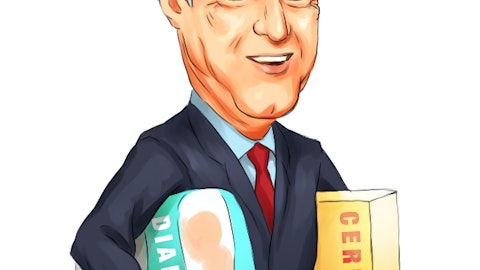In fact, we just had our global sourcing teammates here in Atlanta from all around the world to continue to build on this exciting momentum where all geographies on both sides of the business will be better aligned and more press on where we have our opportunities.So, I wouldn’t say that Asia-Pac is benefiting now more on sourcing. Having said that, they are benefiting from being together as a team, and that’s a big part of how they’re thinking about their business as they move forward.And so whether you’re talking about the organization design, back-office cost, et cetera. I think there’s a lot of opportunities for them to continue to work better as one organization.Bret Jordan Would you do broader integration globally? If it works in Asia-Pac, would you just think about merging more of the overhead on both sides of the business?Will Stengel I think we have an opportunity to work together to leverage our scale, the definition of what you mean by merged business units, probably not.
But working together as a team, you heard at Investor Day, the importance of One GPC. That’s the perfect philosophy around how do we work together to make sure that we’re capturing all the opportunities as a global organization.Bret Jordan Great. Thank you.Will Stengel Thanks.Operator And the next question will be from Scot Ciccarelli from Truist Securities. Please go ahead.Josh Young Hey, good morning. This is Josh on for Scott. So, on the segment margins, with automotive down 60 basis points in the quarter, industrial up over 200. Can you just unpack a little more what the drivers were there for each segment?Bert Nappier Hey Josh, it’s Bert. I’ll take that one, and I’ll start kind of at the GPC level. When we think about — we had margin expansion for gross margin, really, where we’re focused on some of that drag is in SG&A.
SG&A was up 10 basis points year-over-year. That’s really a mix of three factors: inflation, planned investments in the business and then offset by really strong leverage across the business outside of US Auto.For the quarter, when we think about how to really think about the elements, I would say we had SG&A pressure about 50 basis points from those planned investments that we shared at the beginning of the year and again at Investor Day, in IT and talent.Now, some of the talent cost is certainly going to be inflation driven, but we’re making very thoughtful investment in talent and IT, which we see as critical for the future. When you look at US Auto, the quarter was impacted by higher personnel costs there and freight delivery costs.
So that’s the outbound freight from a DC to a store. The wage side was really again the impact of planned investments we made to ensure we’re staying competitive. I think everybody is facing that across all businesses and talent is a key part of our long-term success. On the freight side, we’re seeing the impact of higher rates from our carriers as they’re looking to do the same thing, they’re looking to cover higher wages due to driver shortages. So those two things on the automotive side were part of the equation.The other thing I would just say is that, I turn back to this weather consideration. We really didn’t anticipate that, as you would expect. None of us are forecasters here in terms of weather. But — we didn’t anticipate some of those weather impacts, particularly coming off the very strong December we had in US Auto.
So our staffing models were set to align to a sales run rate where we exited 2022. And that was probably a little bit higher than we needed to support Q1 softer sales level. So all of that together compressed margin in US Auto and was a bit of a headwind for us.As we look ahead, the cost of business is doing a little of doing business is a little higher and inflationary conditions are certainly contributing to that. We’re reducing where we can. And again, investments we’re making in the business that we shared at Investor Day are a big part of driving efficiency.So while two is kind of take that back to the top level again, and maybe talk about these wage investments in IT and why we think they’re so important to us. On the IT side, we’re making investments to improve our capabilities and modernize our platforms and Nadeem share that extensively last month.
We think those are the right things to do. But in certain cases, the pivot in that space is to cloud-based technology. And as many of you know, that changes the dynamic from a capital to operating costs. And as I shared earlier this year, that’s about a 30 basis point drag for us for the year.On the talent side, it’s a very competitive market out there for talent. And we’re making smart investments with our people with a mid-single-digit wage increase. I think that’s in line with most businesses, slightly higher for us than 2022. And we also made the decision to take some of the health care costs we were seeing and absorb them here at the corporate level rather than what we might normally do and pass those on to our employees through higher contributions from them.
And that’s the right thing for our team right now.So I take that all together, we got a little bit of deleverage for the year 30 to 40 basis points. Those two things are 60. So you can see we’re really leveraging outside of that US auto business right now. And with that, we expect margin for the full year to be up 20 to 40 basis points. And as you saw in Q1, we were up 50 basis points.Josh Young Got it. Okay. That’s helpful. And then could you just walk us through what you saw in terms of inflation during the quarter and what your expectations are for the balance of the year here?Bert Nappier Sure. Yeah, I’ll take that one as well. As we look at Q1, inflation moderated slightly during the quarter. That was in line with our expectations. Again, we think monetary policies here in the US and around the world are having the desired effect.
But that does take a little time to flow through. Q1 inflation and sales, all GPC total was mid-single digit. Auto was high single digit. And again, industrial, which has been very consistent, low single digits.Our expectation for inflation for the rest of the year is for it to continue to moderate. That’s pretty consistent with the view I just shared at Investor Day. Obviously, the actual impact is yet to be seen. But our assumption is that the automotive business will tick down from high single digits to low single digits to close out the year. Industrial will stay in that low single-digit range and that GPC that translates in us going from mid-single digit to low single digits.Josh Young Okay. Got it. Very helpful. Thank you.Operator And the next question will come from Christopher Horvers from JPMorgan.
Please go ahead. Christopher, your line is open. Perhaps your line is mute on your end.Christopher Horvers Thanks. Good morning everybody. So a couple of follow-up questions. First, is it fair to say that you were expecting US NAPA to be more like a 4% comp for the first quarter, considering you pointed out a point of on the weather side? And is that a fair interpretation of where the business is running in April?Will Stengel The first part of your question is fair. And the second part of your question is fair.Christopher Horvers Okay. And so dovetailing back to the US NAPA division, you talked about 20 to 40 basis points of segment margin expansion. So was it — is the original plan that you would deleverage the NAPA operating margin due to the investments?Bert Nappier Chris, this is Bert.
So when I talked about 20 to 40 basis points of segment margin improvement, I’m talking about GPC consolidated. I don’t really want to get into parsing the onion too finely between the elements of that. But we were not expecting margin declines in either segment for the year. The math would be difficult to achieve 20 to 40 basis points being up consolidated for either of the two segments to be down year-over-year.Look, we had a softer start to the year in US Auto. We’ve got a great plan here in place with some cost actions we’re taking, but it will take a little time to build traction and auger in through the quarter. We’re looking for a really solid second half there and building that momentum for us, and we feel good about that.Christopher Horvers Got it.
And then just on the freight front understanding that there’s some wage cost being pass-through and driver shortages, fuel prices surged in March of last year and all your freight out, I’m assuming it’s a periodic expense. So should the freight start to be a tailwind here in the second quarter? And then how long before maybe some of the capitalized freight costs turned to a tailwind later in the year? Thank you.Bert Nappier Yeah. Thanks, Chris. It’s Bert again. Look, on the cost of ocean freight, those that are included in our inbound and cost of goods sold. My gross margin projection for the year and our guidance assumes we get a bit of a tailwind of that in the second half. That’s clearly our expectation. I think that’s in line with the market.On the outbound freight, diesel fuel is still up year-over-year just slightly in the quarter.
It started out January, I think, in the north of 20%, moderated a bit in February into the teens and then turned positive in March. The net sum of that was about a 3.5% increase for the quarter in fuel cost. And so we had a bit of a headwind there on top of the rates we’re getting from the carriers in terms of fuel as it relates to diesel, and that is primary — that’s the primary component of that delivery cost as we think about fuel when it goes from the DC to the store. We would expect that, if March is an indicator that, that will start to tick down a bit and could be a benefit to us. Will mentioned that we’ve got some actions related to that.On the labor side, I think it’s pretty sticky, though. When we think about these carriers, and we’re all facing higher wages.
Year-over-year, the cost of doing business is undeniably higher because of wage rates, and I don’t think those will abate. But we might get a little bit of a tailwind here on the fuel aspect and see how that maps out over the next couple of quarters. Sorry for the long answer.Christopher Horvers Got it. Thanks very much. No, thank you so much.Will Stengel Okay. Thank you.Operator And the next question is from Liz Suzuki from Bank of America. Please go ahead.Liz Suzuki Hi, thank you. Just — I guess this is more of a theoretical question about acquisition opportunities. I mean historically, you’ve acquired businesses that are performing well that can bring synergies to your core operations in both Industrial and Automotive. But if there were underperforming competitors in either a category where you saw an opportunity to bring GPC’s distribution capabilities to that business.
Would that ever we consider it as an acquisition target?Will Stengel Yes, Liz, it’s a great question, and the answer is yes. We’re going to do deals that create value that align with our strategy, regardless of how they’re performing. And I would say our capabilities in this part of the business positions us pretty well as the environment gets tougher.We’re going to be really disciplined on whether they’re a good business or a challenged business. But if we can create value and it makes sense for our strategy, I think the power of our balance sheet and our liquidity position is that’s exactly the type of environment that we want to operate in, so we can leverage our scale.Liz Suzuki Got you. And then just on the guidance for the year, the interest expense came down a little bit.
So it sounds like there are no near-term plans to take on additional leverage, but just wanted to get your thoughts about that and on your current debt level and any near-term plans for cash outside of the opportunities that you laid out already in your — in the slides.Bert Nappier Hi, Liz, it’s Bert. Look, there’s nothing in the near-term that has really changed or really for the balance of the year in terms of how we’re thinking. Interest expense has come down a bit. We’ve had a little less need to borrow against our revolver intra-month, which has been a bit of a benefit to us and intentional.And then when we think about the uses of cash and our capital allocation for the year, it’s still pretty balanced. We don’t have anything different than what we shared at Investor Day and no different plans.
The only thing that’s on the horizon is we’ve got a debt maturity at the end of the year. And obviously, we’ll want to be thinking about the environment that the capital market brings to us as we get closer to that and how we think about refinancing or paying back or some of the various options we might have. So again, just being really disciplined as we always are being faithful to our four priorities on capital allocation and no surprises for you guys.Liz Suzuki Perfect. Thank you.Bert Nappier Yes.Will Stengel Thanks, Liz.Operator And the next question is from Greg Melich from Evercore ISI. Please go ahead.Greg Melich I have a follow-up on Auto and then turn to Industrial. I just want to make sure on the Auto margin, it looks like the decline was pretty much all in the US business.




